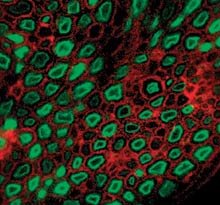Genetic ‘Light Switches’ Control Muscle Movement
September 27, 2010 | Source: Technology Review

Cross-section of a mouse sciatic nerve genetically engineered to produce a light-sensitive protein (shown in green) to trigger muscle movements (Nature)
In the near term, optogenetics technology will improve the studies that the lab and others do on muscle activity in animal models of stroke, palsies, ALS, and other neuromuscular disorders, says Scott Delp, a professor of bioengineering, mechanical engineering, and orthopedic surgery at Stanford.
In the future, such optical switches could be used to help patients with physical disabilities caused by nerve damage such as stroke, spinal cord injury, or cerebral palsy, he suggests.